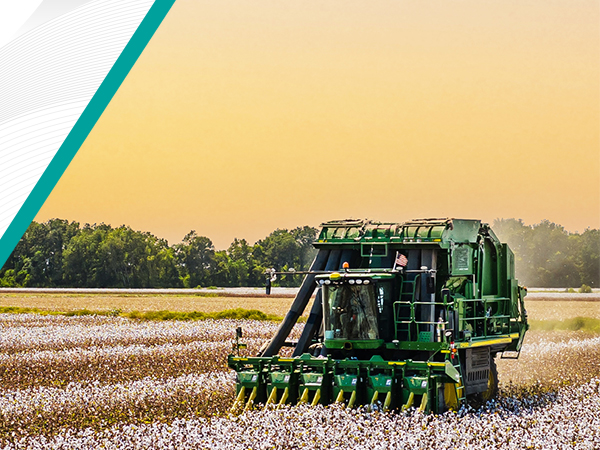Keep an Eye Out: New Trends in the AG Industry 2023 is rolling to an end, but industry advancements and changes remain …


The cotton-picking industry is one of the most important economic activities in the
US today, with the country being the third-largest exporter of cotton after India and China.
It is a tricky crop to harvest; production heavily relies on climate, water, and pest control,
with a maturity period of around 160 days on average, depending on location.
Nowadays, there are two basic options for harvesting equipment: cotton pickers
and cotton strippers. Both are designed to fulfill the same function, but the operation
method and picking results differ. Cotton strippers are primarily used in areas where
repetitive picking is nearly impossible, allowing only a single harvest, primarily due to
weather conditions. The stripper pulls the entire boll out or cuts it close to the ground,
taking the cotton, the stalk, and any debris, even if it’s still closed and not ready for
harvest. Later, a different machine will separate the cotton from the other materials.
Pickers are the most common, allowing for multiple harvests as the bolls begin to
mature. The equipment will enable farmers to harvest only the opened bolls through
moisturized prongs or barbed spindles rotating at high speed; later, the cotton is removed
by a counter-rotating doffer and then blown into a basket that collects it for baling. This
method is softer and less invasive, picking up between 95% and 98% of the total field
production.
The Picker Spindle Road
The cotton industry had its initial expansion in early 1800, becoming the most
prominent export. This growth happened partially due to slave labor, which has
unfortunately become synonymous with the activity even to this day.
Due to the American Civil War, significant technological advances for cotton
equipment arrived late. With the help of his brother Mack, John Rust is credited with
developing the first models of a mechanized cotton picker in the early 1930s. Even though
Rust machines did fulfill their purpose, they were expensive and deficient. Adding to the
already tough market, industry developments were delayed due to World War II, which
shuffled manufacturing processes towards war efforts.
After the War ended, companies began to center their attention on the fields again,
developing better, mechanized picking systems often based on the Rust’s models.
Improvements aimed to pick the fibers better and reduce clogging, although the number
of cotton rows to pick often amounted to one at the time. As positive as this development
may sound, the mechanization of agricultural operations is often cited as one of the
causes of the Second Great Migration, which forced hundreds of workers to move to
urban areas to seek employment and better conditions.
After the 1950s and into the 1980s, the commercialization of mechanized pickers
started to gain greater traction, with models that incorporated better shapes and more
functional tools, adding steel frames and more efficient row systems. Later improvements
and better technology have turned the equipment into the practical piece of machinery
that is today
Keeping the Spindle Rolling
As the cleanest and most efficient method, picker spindles are essential pieces of
equipment that must be kept in optimal condition to perform well. They are complex and
require training and skill to be properly operated and maintained. Spindles are prone to
wear and rust, and they can lose sharpness with use, impacting other parts of the system.
They must be sharp, clean, and correctly assembled for optimal operations and to reduce
the risk of damage. It is crucial to inspect the equipment thoroughly, verifying the row unit
tilt, and adjust if necessary. Doffers and moistening systems must be adjusted and
checked for wear and debris, and plant lifters should be operating at the right level for
guidance. Follow the manufacturer’s manual and professional expert advice to perform
preventative maintenance and repairs to the equipment.
VISCOSITY Oil has been developing optimal formulations for over 125 years,
adapting to the industry as mechanical and technological advances keep changing the
agricultural industry dynamic. We have designed a specialized product to help cotton-picking operations, adding protection, and keeping parts clean for optimal performance.
TUTELA® Spindle Cleaner keeps your picker safe against wear, debris, residues, and
contaminants that may hinder its functionality, reducing wrapping, and staining. Avoid
rust, corrosion and keep your equipment clean for the best operation during the cotton
harvest season. Browse our line of products and continue working in fluid motion with
VISCOSITY Oil, formulated for ALL.
RELATED ARTICLES
Harvesting Success: Crop Rotation and Cover Crops Crop rotation and the use of cover crops are key tools for sustainable farming practices …

